The Ultimate Hip Strength and Mobility Workout
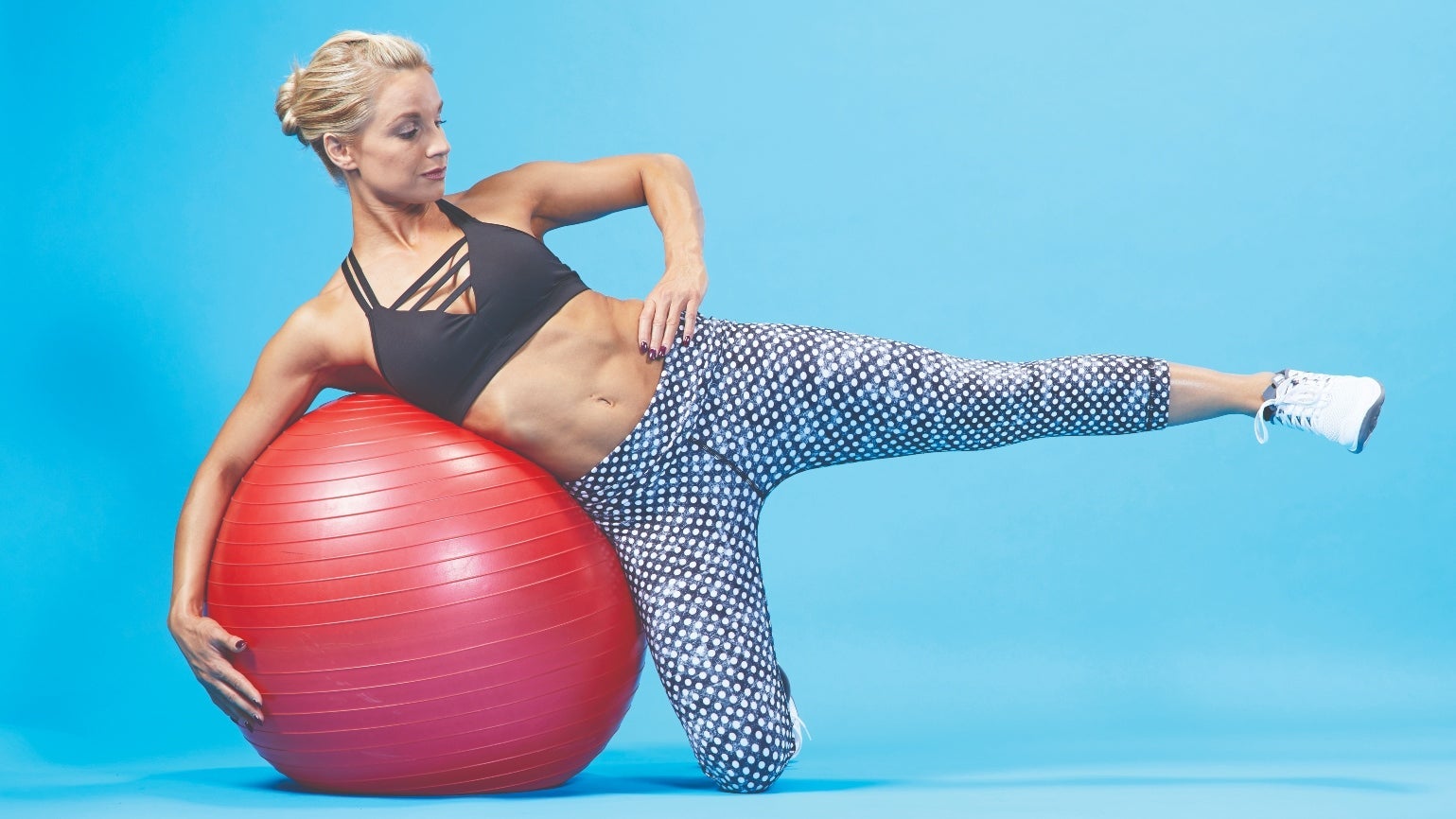
(Photo: Peter Lueders)
If you were asked to identify your core muscles, what would you name? Probably the rectus abdominis, the obliques, the lower back, maybe even the glutes. Sure, those are the glamour players that get the most press, but when it comes to primary core function, especially in swim, bike, and run, there are some other very important muscles to consider — those in your hips.
In actuality, the pelvis and hips are your seat of postural power, and this central region is responsible not only for propelling you forward, backward or sideways but also for keeping your back and knees happy when standing or sitting. And since the primary functions of your core are to transfer force from one extremity to another and to act as a stabilizer/initiator of a movement, the hips should absolutely be included when programming your core training.
RELATED: Essential Tests and Exercises for Better Hip Mobility (And Happier Hamstrings)
Chain Reaction
More than 20 muscles cross, insert into or originate in your hips, all pulling, pushing relaxing and contracting at any given time. With all this kinetic activity around a single, central location, it’s no wonder your hips can become problematic.
Most issues stem from an imbalance between opposing muscle groups, and if one muscle is out of balance — either too tight or too lax — it causes a chain reaction that can affect you from head to toe. Sedentary jobs and lifestyles have a lot to do with this problem. For example, if you sit all day, your hips are continually flexed, causing the fibers of the psoas and iliacus (hip flexors) to shorten while the abdominals and glutes relax. When you finally stand, those tightened muscles pull your pelvis forward and the abs and glutes — whose job it is to correct this shift — are caught sleeping on the job. The muscles in your posterior chain then have to support your entire upper body, causing tightness and pain in your lumbar area, shoulders and neck.
RELATED: The Long-Term Effects of “Work-From-Home Posture” Are Killing Your Training
But hip issues aren’t relegated to the sedentary sect, and athletes might have the opposite problem: Since many strength-training exercises focus on posterior-chain development, the muscles in the glutes and hamstrings are overstimulated and tight, pulling the pelvis rearward and causing it to tuck when standing. Now the lower back is completely flat, which over time could lead to bulging discs in the spine.
The list of push-me-pull-you examples could go on for pages, but the simple take-away is this: Implementing programs like this one, which includes strength and mobility work, can balance out your hips and once again make your core a nuclear powerhouse both in the gym and out of it.
Strengthening Moves
Stability-Ball Hip Series
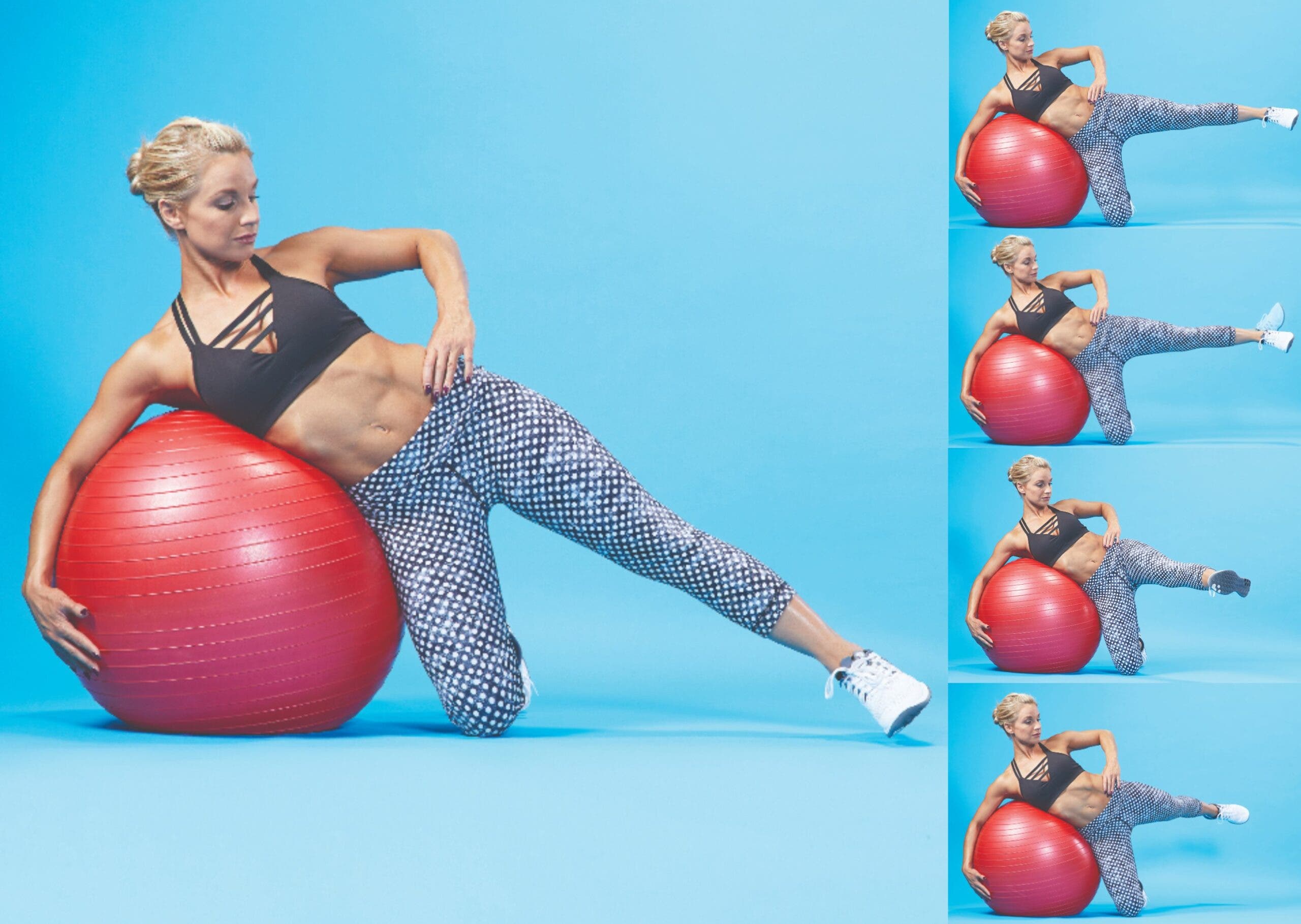
Lie on your side on a stability ball and extend your top leg so it’s straight. Bend your bottom leg, place your knee down and hug the ball with your bottom arm for stability (A). Keep your hips stacked and brace your core to prevent rolling as you perform this sequence slowly and deliberately:
- Lift your top leg as high as possible without bending at the waist (B). Lower it to touch the ground briefly, then raise back up.
- Lift and hold your leg at hip level, rotating it outward and inward slowly from the hip (C).
- Lift and hold your leg at hip level, then bring it forward (D) and rearward (E) as far as possible while keeping your hips stacked.
Standing Single-Legged Knee Drive

Attach an ankle strap to a cable machine (or secure a band with an ankle strap to a stationary object). Stand on one foot facing away from the anchor and find your balance, then extend your working leg behind you. Drive your working knee up to hip height while driving your same-side elbow back, as if sprinting. Slowly return to the start and repeat right away. Do all reps on one side before switching.
Band-Assisted Single-Legged Squat
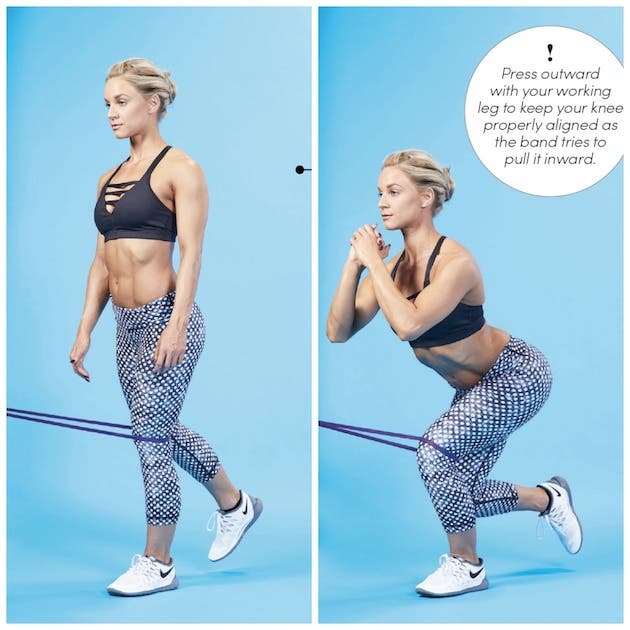
Stand sideways to a stable object and anchor a band at knee height. Step inside the loop with your outside leg and position the band just above your knee, lifting your inside foot off the floor. Squat down as far as you can while keeping your chest lifted. Return to the start. Do all reps on one side before switching.
Rotating Airplane
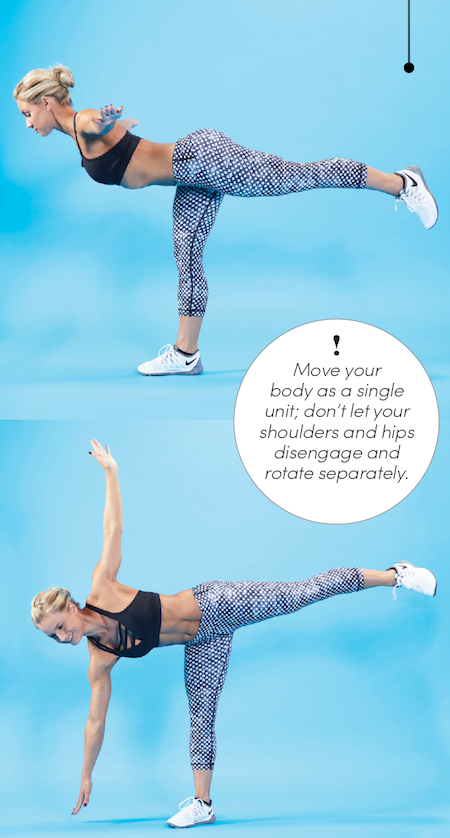
Stand on one leg, knee soft, and extend your arms to the sides at shoulder height. Hinge at the hips and lower your torso and raise your opposite leg simultaneously until both are parallel to the ground, hips level. Find your balance, then slowly rotate your entire body away from the standing leg until your hips are open and stacked and your arms are perpendicular to the floor. Rotate back to airplane and repeat. Do all reps on one side before switching.
Sample Workout: Strengthen Your Hips
Begin your leg workout with these moves, focusing on quality over quantity. Once your hips are responding, add a couple of these moves to your workout for maintenance.
| Move | Target Muscles | Sets | Reps | Weight | Tempo |
| Stability-Ball Hip Series | gluteal complex, hamstrings, deep rotators | 3-5 | 10-15 each move per side | bodyweight or 1- to 3-pound ankle weights | 4 counts each rep |
| Standing Single-Legged Knee Drive | hip flexors, opposing leg hip stabilizers | 3-5 | 10-15 each side | light/moderate band or 5- to 20-pound cable resistance | slow until stability is established, then increase tempo |
| Band-Assisted Single-Legged Squat | gluteus medius, deep external rotators | 3-5 | 10-15 each side | bodyweight + moderate resistance band | 4 counts down, 2 counts up |
| Rotating Airplane | internal/external rotators, stabilizers, abdominals | 3 | 8 each side | bodyweight | 4 to 6 counts |
RELATED: The 30-Minute Mobility Routine That Helped Ben Kanute Nab His Second 70.3 World Championship Podium
Mobility Exercises
Foam Rolling: Hip Flexors
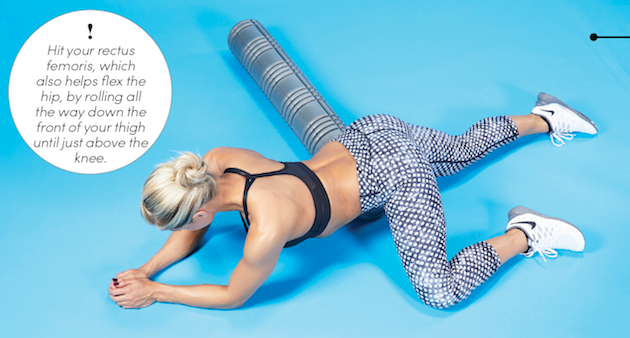
Lie facedown and position the foam roller underneath one hip, extending that leg behind you. Bend your other knee to the side for support. Keeping your hips level, roll slowly back and forth over the hip flexor, pausing on any tight or painful areas.
Foam Rolling: Gluteals and Piriformis
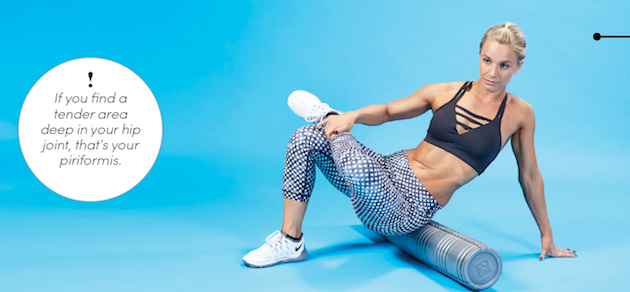
Sit on the roller and cross your left ankle over your right knee. Lean toward the left side and roll back and forth, side to side, to hit your entire gluteal group.
Supine Adductor Stretch
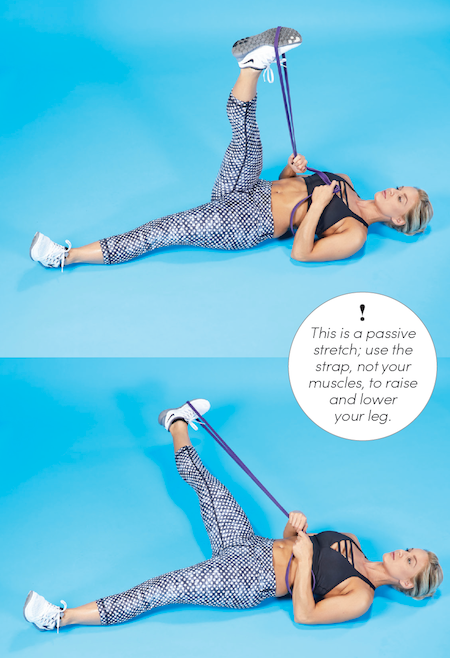
Lie on your back and wrap a strap or band around one foot, then extend that leg over your hip, foot flexed. Ground your glutes and open your leg to the side until you feel a stretch in your inner thigh. Hold and breathe, then return to the start. Do all reps on one side before switching.
Dynamic Stretch: Reverse Lunge and Reach to Standing Figure-4
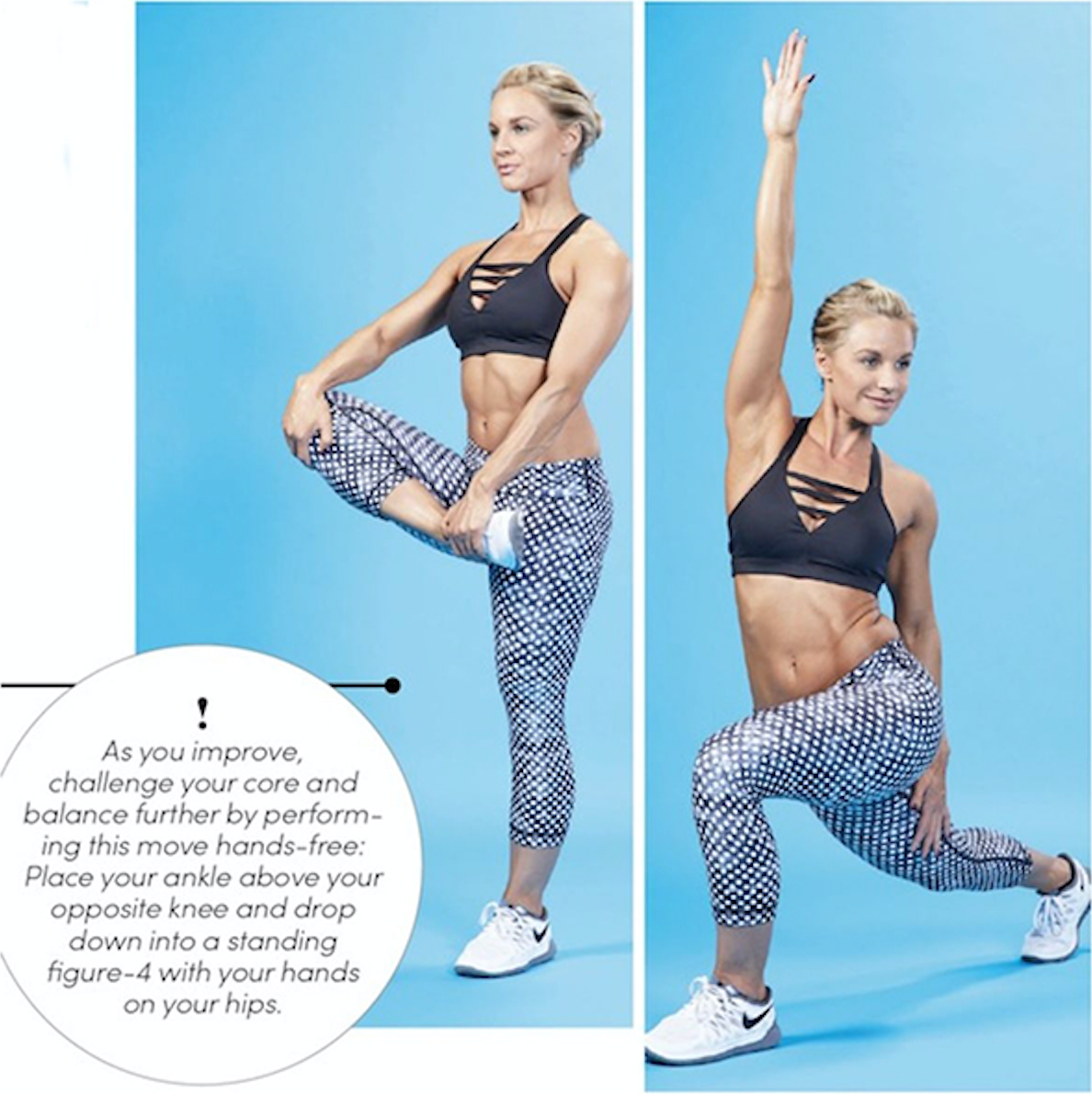
Lunge back with your right leg, then reach up and over your body with your right arm and reach back to touch your hamstring with your left hand. Return to the start, then lift your right leg into a figure-4 position at hip height, grabbing your knee and foot and pulling gently upward and inward. Do all reps on one side, then switch.
RELATED: How to Build Hip Mobility Safely
Sample Workout: Mobilize Your Hips
Integrate these moves into your warm-up, or do the routine as a stand-alone to release some end-of-day tension. When foam rolling, pause on each tender spot for 20 to 30 seconds, and when doing static stretching, hold and breathe for 30 seconds each side.
| Move | Target Muscles | Reps/Time |
| Foam Rolling: Hip Flexors | hip flexors | 2-3 minutes per side |
| Foam Rolling: Gluteals and Piriformis | gluteal complex, piriformis and deep hip rotators | 2-3 minutes per side |
| Supine Adductor Stretch | adductors | repeat 2-3 times per side |
| Dynamic Stretch: Reverse Lunge and Reach to Standing Figure-4 | total hip complex | 8-10 reps each side |
RELATED: Ask A Trainer: How Should I Use a Foam Roller During Race Season?
Happy Hips = Kick-Ass Performance
A study published in the Journal of Strength and Conditioning showed that stretching alone does not increase your hip range of motion during functional movements, and that in fact you need to ingrain a new movement pattern into your regular training in order for it to become second nature. This can be done during the dynamic warm-up, by taking your joints actively through their full range of motion (for example: reverse lunge and reach to standing figure-4) while activating your core and priming the nervous system to control a new movement pattern.
But the big takeaway here: If you take care of your hips, they’ll take care of you. As you progress through your training plan, make sure to give your hips the strength and mobility attention they deserve.